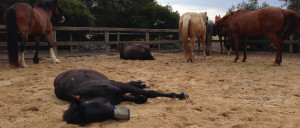One morning minutes before a client was to arrive I found Finn – our 5-month-old orphan foal, stuck against the fence. In equine circles, this is referred to as being cast. When a horse becomes cast, it may feel entrapped and unable to regain its feet and can panic. As it flails and struggles, it can injure itself and the struggling horse can also hurt anyone who comes near. This is not just a good time to become neutral, it’s critical for the safety of the cast horse and helping humans. Situations like this have taught me the power of being neutral.
The story we give to a situation creates our emotional charge
We are instinctively good at staying neutral when a child falls down and runs to us bleeding. We don’t panic and scream “you’re bleeding to death,” but rather we stay calm and focus on what needs to be done. We could all be more peaceful, content, and less stressed if we could remember to be that way and stay neutral in any challenging situation. It is the story we give to it that creates our emotional charge. Take traffic jams for example. A traffic jam is just a traffic jam. It is neutral. It just is. Ask 20 people what they felt during a traffic jam and you are likely to get 20 different responses from angry, frustrated, anxious, annoyed, to unaffected, peaceful, and relaxed – depending on what they were thinking and where they were going. For example, someone who is running ahead of schedule and doesn’t want to arrive too early might welcome the delay caused by the traffic jam, while someone who is on their way to attend an interview might feel anxious about missing a job opportunity.
Being neutral keeps us open and present
Being neutral does not mean being detached, complacent or passive. It means being present to what is happening without limiting outcomes through judgement and stories. Thinking about what could happen puts us in the future, or thinking about what should have happened shuts us down from seeing new possibilities.
Shifting into neutral
It’s nearly impossible to shift from feeling angry to feeling peaceful. The gap is usually too big. But it is possible to recognise that it’s our story we tell about the situation that creates the emotional charge. With this awareness, we can choose to let our story loosen its grip and slip into neutral.
Having a neutral perspective is a higher state of consciousness
A neutral perspective instantly expands our awareness, creates a space for possibilities to emerge, and aligns our emotional resonance with Nature. The reality we experience can only match our resonance.
Neutral = grounded and centered
A neutral perspective keeps us in balance, and we can stay grounded. It’s from this mental and emotional centre that we have access to all our resources and wisdom to make better choices and take appropriate action for our highest good.

